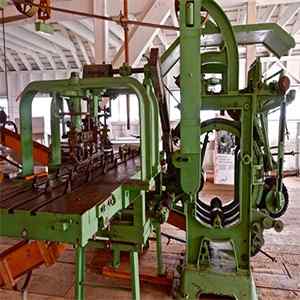Optimizing Inventory Management with Power Scraping Technology

Introduction
In the fiercely competitive manufacturing landscape, effective inventory management plays a pivotal role in ensuring optimal production efficiency, cost control, and overall customer satisfaction. Conventional inventory management methods often involve manual data entry and monitoring, leading to errors and delays. However, with the integration of power scrapers into manufacturing automation systems, a new era of inventory management has emerged, empowering businesses with real-time, data-driven solutions through Power Scraping Technology. This article delves into the transformative role of power scrapers in streamlining inventory management processes, optimizing supply chains, and elevating manufacturing efficiency to new heights.
The Need for Data-driven Inventory Management
In today's rapidly changing manufacturing landscape, maintaining a competitive edge requires efficient inventory management. Traditional methods relying on manual data entry and outdated record-keeping systems often result in inaccuracies and delays. This, in turn, hinders manufacturing efficiency and cost control, leading to missed opportunities and reduced profitability.
To address these challenges, manufacturers are increasingly adopting data-driven inventory management practices with the help of Power Scraping Technology. By leveraging the power of technology and automation, businesses can access real-time data insights on inventory levels, demand patterns, and supplier changes. This enables timely decision-making, allowing companies to respond swiftly to market demands, prevent stockouts, and optimize inventory levels.
The advantages of data-driven inventory management are multifaceted. Firstly, it provides better visibility into inventory levels, enabling manufacturers to maintain optimal stock levels and reduce carrying costs. Secondly, by analyzing historical data and demand patterns, businesses can accurately forecast future demands and adjust production schedules accordingly, leading to reduced lead times and enhanced customer satisfaction. Finally, the availability of up-to-date data facilitates a more agile supply chain, enabling manufacturers to respond rapidly to changing market conditions and outperform competitors.
Understanding Power Scrapers
Power scrapers are sophisticated software tools designed to automate the process of extracting data from websites and online platforms. They use predefined algorithms to navigate web pages, locate relevant information, and collect it in a structured format through Power Scraping Technology. Power scrapers are widely used for web scraping tasks, including data extraction, data transformation, and data loading.
Within the realm of inventory management in manufacturing automation, power scrapers assume a pivotal function by collecting real-time data from diverse origins. These scrapers adeptly retrieve inventory information from suppliers' websites, e-commerce platforms, marketplaces, and internal databases. Through the automation of data extraction, power scrapers effectively conserve valuable time and resources, while also mitigating the potential for human errors, thus upholding the precision of inventory data.
Real-time Data Acquisition
Real-time data acquisition is a game-changer in modern inventory management. With power scrapers integrated into manufacturing automation systems, businesses can access up-to-the-minute information on inventory levels, product availability, and supplier updates. This real-time data flow enables manufacturers to make informed decisions and ensures a responsive and agile supply chain.
In traditional inventory management methods, data updates often have delays, which can result in outdated information. For instance, inventory levels might not be accurately reflected due to the time lag in manual data entry. However, power scrapers continuously monitor and collect data in real-time through Power Scraping Technology, providing a live stream of information on inventory status. As a result, manufacturers can take immediate action to replenish stock when inventory levels are low or adjust production schedules based on real-time market demand.
Inventory Optimization with Power Scrapers
Power scrapers empower manufacturers to optimize their inventory levels by harnessing the power of data analytics. By analyzing historical inventory data and demand patterns, businesses can identify trends and predict future demand more accurately. This predictive capability allows manufacturers to maintain optimal inventory levels, minimizing the risk of stockouts and overstock situations.
Stockouts arise when products are unavailable during customer demand, resulting in missed sales prospects and discontented customers. Conversely, overstock scenarios tie up operational funds, occupy precious warehouse area, and escalate upkeep expenses. Powered by data-centric insights, power scrapers empower manufacturers to attain an optimal equilibrium between inventory quantities and demand. This optimization of inventory management practices guarantees timely product availability without unnecessary accumulation of excess stock, fostering efficient operations.
Supply Chain Integration
The integration of power scrapers with manufacturing automation systems and enterprise resource planning (ERP) software is a key enabler of efficient inventory management in the manufacturing industry. Seamless data flow across the supply chain enhances collaboration and coordination among different departments, suppliers, and customers.
Power scrapers can extract inventory data from various sources and seamlessly integrate it with the organization's existing systems through Power Scraping Technology. This integration ensures that relevant stakeholders have access to accurate and up-to-date information, enabling them to make well-informed decisions in real time. For instance, production planners can adjust manufacturing schedules based on inventory levels, while procurement teams can efficiently manage supplier relationships based on real-time supplier data.
A thoroughly integrated supply chain diminishes the presence of isolated information pockets and amplifies transparency, fostering heightened efficacy in decision-making across the manufacturing journey. The outcome is a streamlined and agile supply chain that can promptly adjust to evolving market circumstances.
Heightened Forecasting and Demand Preparation
Forecasting and demand preparation represent integral elements of efficient inventory management. Power scrapers assume a pivotal role in offering valuable data insights to augment these procedures. Through the examination of historical sales data, customer actions, and market trends, manufacturers can develop more precise demand forecasts.
Power scrapers can monitor changes in customer preferences, competitor activities, and market conditions in real time, providing manufacturers with a holistic view of the market dynamics. Armed with this information, businesses can develop more robust demand planning strategies, aligning production schedules with anticipated demand fluctuations.
Precise demand forecasting mitigates the possibility of excessive stockpiling or inadequate product supply, empowering manufacturers to fine-tune their production methods and curtail lead times. Consequently, this results in heightened customer contentment, as products are conveniently accessible when desired by customers.
Inventory Cost Reduction
Optimizing inventory levels with power scrapers directly contributes to reducing inventory costs for manufacturers. Maintaining leaner inventory levels means less capital tied up in stock, which can be allocated to other areas of the business, such as research and development, marketing, or expansion initiatives.
Through the reduction of carrying costs linked to surplus inventory, enterprises can attain enhanced financial efficacy. These carrying costs encompass storage fees, insurance, handling charges, and the capital opportunity expense tied to inventory. Power scrapers empower manufacturers to consistently scrutinize inventory data and adapt their stock levels in accordance with live demand, thereby securing a streamlined and effective inventory management approach.
Additionally, reducing inventory costs positively impacts a company's profitability, making it more competitive in the market. It allows manufacturers to offer competitive pricing, invest in innovation, and maintain a healthy financial position.
Data Security and Compliance
While the benefits of power scrapers for inventory management are substantial, manufacturers must address data security and compliance concerns. Since power scrapers extract data from various sources, including suppliers' websites and marketplaces, it is essential to ensure the protection of sensitive inventory information.
To maintain data integrity during extraction, storage, and transmission, it's crucial to incorporate data security measures, including encryption and access controls. Manufacturers should also establish robust protocols for data management and internal sharing to prevent unauthorized access to vital information.
Moreover, compliance with relevant data protection and privacy regulations is paramount. Different regions and industries have specific data protection laws that govern the handling of personal and sensitive data. Manufacturers must ensure that their power scraper implementation adheres to all applicable legal requirements to avoid legal repercussions.
Future Trends and Potential Challenges
Looking ahead, the future of power scrapers in inventory management holds promising trends. As technology continues to evolve, power scrapers are likely to become more sophisticated, offering enhanced capabilities, increased automation, and improved integration options. Manufacturers can expect even faster data extraction, seamless integration with AI and machine learning algorithms, and greater compatibility with various data formats and systems.
However, with these advancements come potential challenges that manufacturers should be prepared to address. Data privacy concerns are likely to become more significant, given the increasing emphasis on data protection regulations worldwide. Manufacturers must stay vigilant about protecting sensitive inventory data and maintain strict data security measures.
Furthermore, resistance to adopting new technologies can present a hurdle. Implementing power scrapers and transitioning to data-driven inventory management may require changes to existing workflows and employee training. Clear communication, stakeholder engagement, and effective change management strategies will be essential to overcoming resistance and maximizing the benefits of power scrapers.
Conclusion
In conclusion, the integration of power scrapers into manufacturing automation systems is revolutionizing inventory management in the manufacturing industry through Power Scraping Technology. Leveraging real-time, data-driven insights empowers businesses to optimize inventory levels, streamline supply chains, and achieve superior manufacturing efficiency. By embracing power scrapers for inventory management, manufacturers can navigate the dynamic and competitive landscape of modern manufacturing successfully. It is a strategic move that propels manufacturers into a more agile and competitive future, ensuring sustained growth and customer satisfaction.







